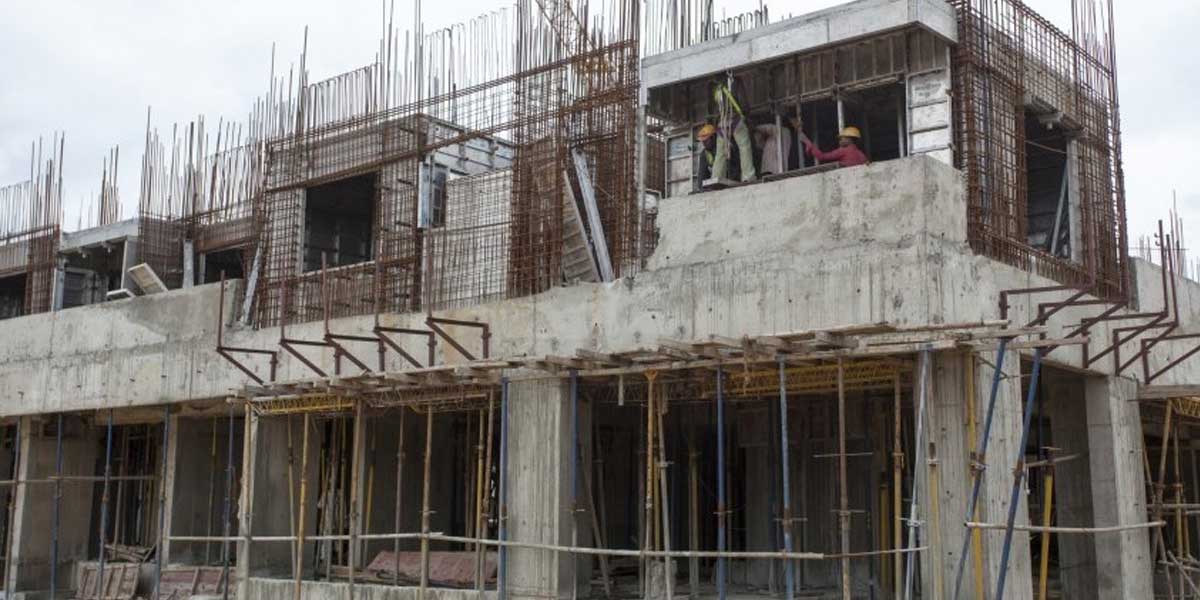AVIK MUNSHI and DR DEVANGSHU PANDIT elaborate upon opportunities and barriers.
Cities have facilitated human evolution through propagation of ideas, as economist and professor Edward Glaeser puts it. Urban innovations ranging from the Roman aqueduct that transported water to the hyperloop that moves people have facilitated urbanisation, while idea innovations ranging from readymade garments to IT have improved human lives. Although human conglomeration originated from convenience, today it is driven by consumerism. The accrued productivity gains of millions of inhabitants make billion-dollar infrastructure projects viable through economies of scale, while the convenience of access to recreational and educational facilities attracts inhabitants.
Over the past few decades, real-estate development, or urban development in a broader context, has served to satisfy this perpetual demand of economic growth along with the subsequent benefits to human lives. Development, as defined academically, constitutes of any activity that adds value to otherwise unutilised or underutilised space, according to real-estate development expert and professor Richard Peiser. For instance, it can be argued that, from an economic standpoint, a piece of land with a multistorey building housing hundreds of analysts is more valuable than a farmland producing tonnes of wheat every year.
Expanding built urban space
In the pursuit to satisfy greater economic and individual consumer demands, we added millions of square feet of built urban space. Earlier, urban sprawl seemed to be the most feasible means, in the absence of advanced building methods and construction technology and accompanied by lax or often corrupt practices in building approval. As the profitability of such development depends on low purchase cost of land, which appreciates only through the orchestrated efforts of developers, this conventional approach became too profitable to discard. In the words of the late real-estate expert and professor James Graaskamp, the profitability of one enterprise is always balanced at an expense from another enterprise, either as indirect or direct costs. Hence, urban bodies realised that developer profits from cheap land would indirectly cost occupants in form of inconveniences requiring addressal through public projects with direct costs.
Hence, the urban administrations shifted focus from creating value on unutilised land to efficiency and sustainability of the value created by the built space. In tangible terms, efficiency is concerned with the utilisation of permissible FSI (floor space index; or FAR – floor-area ratio), thus accommodating as many occupants as possible, whereas sustainability is concerned with the ability to acquire, develop and operate the built space in a manner that causes an acceptable level of environmental degradation, through conservation of farmland, and optimum consumption of water and energy resources.
Moreover, as our needs evolved, urban spaces were extensively retrofitted to incorporate such needs, ranging from air-conditioners to wireless Internet. Also, as a consequence of technological leap or statutory regulations, entire systems, such as firefighting equipment, have been added. In the process, certain elements of premises are utilised beyond designed function and load capacity, impacting overall service life. Within the next decade, the numerous buildings built during early urbanisation will approach the end of their design life and encounter serviceability issues, requiring major interventions. Hence, redevelopment has emerged as a means not only to increase the population density on land with existing public infrastructure but also to support the upgradation efforts of existing building owners.
The shifting focus of urban administrations has led to increased FSI in developed localities and transit corridors. For instance, the urban local body of Ahmedabad now permits an FSI of 5.4 in the Central Business District and FSI of 4.0 along the Transit Oriented Zone (Comprehensive General Development Control Regulations, 2017), against the original 1.2 or 1.8. Such changes along with zoning amendments allow a variety of urban development opportunities for repurposing of older assets. However, despite numerous such policy interventions, certain hindrances prevail owing to the complex guidelines and processes. This article intends to highlight such roadblocks alongside the opportunities.
Defining redevelopment
Any real-estate activity can be classified as development as long as it creates value to the existing space, whether land or building. The value can be either in tangible form such as additional floor space or intangible such as productivity improvement. Although any added utility can be considered development in case of vacant land, this is not the case for redevelopment. For instance, would a project for replacing an old depleted structure be considered redevelopment or reconstruction?
Redevelopment has been defined as any new construction on any land or premises that has been previously developed, partially or fully occupied, but not utilised up to its full potential, in an article by S Alker, V Joy, P Roberts and N Smith in the Journal of Environmental Planning and Management. Hence, a project should be classified as redevelopment only if it contributes incremental utility. As the intangible value of socioeconomic benefits is difficult to measure, and sometimes irrelevant to the developer, most consider tangible forms such as increased floor space and improved serviceability. However, from a nationwide perspective, the cumulative impact of economic gains from resource efficiency and social gains from occupancy standard enhancement can have a significant positive impact in the long term.
Opportunities offered by redevelopment
Land is considered the single most important resource in real-estate development. However, most advantages arising out of it pertain to its location, as Graaskamp pointed out, adding that just as manufactured components serve as integral parts of a larger mechanical system, so does real estate by functioning as integral parts of a larger system such as the city, necessitating movement of people and goods. Therefore, in addition to the socioeconomic benefits of urban density, the location induces specific tangible benefits that are relevant to the consumer and the producer.
The first (in chronology) and biggest risk in real-estate development arises from the uncertainty of future development within the vicinity of the selected land parcel, according to Peiser. Although such risk can be minimised by the collective and orchestrated efforts of developers, the uncertainty persists unless the area is attended by the third group of stakeholders, the public infrastructure that includes utility connections as well as shared facilities. Redevelopment minimises such risk as sites are in localities with existing public infrastructure, such as sewer connections, water supply, telecommunication lines and transit modes that facilitate movement of people, information and goods.
Moreover, in Graaskamp’s view, the price of real estate, or the lucrativeness of the land parcel, is greatly affected by the consumer’s perceived value of functional benefits associated with the use of built space. As urban spaces function as parts of a large, interconnected web that moves people, information and goods, consumers interpret the presence of utility infrastructure and access to shared facilities as convenience that reduces their direct and indirect costs of access. This offers a competitive edge to developers by improving the saleability of the final product and reduces the need for greater efforts required to propel development or to lobby urban administration.
As Peiser expressed, land cost is a significant factor that depends on the type of site and development. As land cost is considered directly proportional to location lucrativeness, often dictated by accessibility, urban and suburban land parcels have high prices necessitating huge investments in land acquisition. Such investment requires good credit rating and entails high borrowing costs. Thus, it subsequently raises barriers for development. In such a scenario, redevelopment projects that comprise property rights arrangements with existing owners offer an opportunity to undertake projects without extensive borrowings that significantly affect their profitability.
CHALLENGES IN REDEVELOPMENT
Interplay of stakeholders
According to Graaskamp, risk in real estate can be defined as the difference between the projected development and the actual development. Although such associated risks are higher with new development compared to redevelopment, the risk-reward ratio is balanced by higher profitability from lower land acquisition costs and subsidies. Moreover, economic forces play a significant role in shaping the supply and demand forces in the real-estate market, whether in form of tax subsidies to boost affordable housing development or tax exemption on loan interests to boost home ownership, as Glaeser writes. And as much real-estate development is consequential to such socioeconomic forces, such incentives for new development along with uninterrupted supply of land make redevelopment seem like a dismal cousin.
According to Graaskamp, real-estate development involves three groups of stakeholders – the consumer, the producer (or developer) and the public infrastructure – all benefiting from cooperation and each influencing the decisions of other two groups. Also, as Peiser explains, real-estate development is a collaborative effort of numerous professionals and businesses, including urban planners, architects, brokers, lawyers, engineering consultants, construction contractors, banks and financing corporations, and project managers.
In new development, as all involved parties belong to the stakeholder group of producers, efforts are channelised to ultimately fulfil the requirements of only one party: the developer. But unlike new development projects, in which consumer stakeholders are initially absent, consumer stakeholders are onboard right from the outset in redevelopment projects. The objective of the consumers is to elevate their sense of satisfaction arising from the utilisation of the built premises whereas the developer’s objective is to generate profit. This introduces competing objectives.
Moreover, the regulations enforced to protect the rights of the consumer not only counterbalance the disproportionate power of the developer by empowering consumer stakeholders but also increase the stakeholder management efforts of the developer by involving regulatory agencies. For instance, Mumbai has an opportunity to redevelop 16,000 buildings and each involves multiple consumer stakeholders such as tenants, landlords, trusts, developers and regulatory agencies such as BMC (Brihanmumbai Municipal Corporation), MHADA (Maharashtra Housing and Area Development Authority) and Mumbai Building Repairs and Reconstruction Board (MBRRB) and others, as M Bose wrote in Deccan Herald in July 2017. This may result in power struggles that lead to a deadlock as no party possesses the disproportionate power required to overrule everyone else. This creates a unique situation in redevelopment, greatly increasing the efforts required in terms of talent, money and political skills to negotiate a favourable outcome. This further affects the effort-reward ratio, reducing the lucrativeness of such projects.
Interplay of development regulations
Development codes serve as guidelines to prevent haphazard development subject to the free will of the developers and to ensure planned growth of urban centres as deemed appropriate by city planners. However, such codes can also curtail development; for instance, many iconic New York skyscrapers are a by-product of the absence of regulations, while the introduction of development regulations led to the longest, almost three-decade, stall of skyscraper development in New York City, according to Glaeser. Although regulations may not be directly detrimental, the concerned authorities should ascertain that the cumulative implications do not inhibit redevelopment prospects.
Although FSI is a critical factor in redevelopment projects, the utilisation of permissible FSI is often subject to the cumulative impact of development guidelines. Additional FSI offers tangible gains in form of saleable floor space; however, the materialisation of such floor space is subject to permissible building height and floor plate. For instance, in an irregularly shaped plot, the floor plate area can be greatly reduced while complying with margins and common plot requirements. This, along with height restriction owing to lesser width of adjacent road, can greatly limit FSI utilisation. Moreover, inclusion of common amenities in saleable space results in lower carpet area and subsequently higher unit prices of carpet area for the consumer, and affects the market competitiveness of the developer. For instance, in certain regions, parking above the ground floor is included in saleable area, compelling developers to incur higher cost of underground parking to avoid higher unit prices for consumers.
Moreover, development regulations are intertwined with building design codes and heritage guidelines. The varying construction practices and technology across regions may result in stringent building codes that do not allow the complete utilisation of the potential offered by development regulations. For instance, absence of adequate fire-fighting provisions and technology adoption limits permissible building heights. Also, as developed localities in most cities have aged beyond seven decades, many buildings are either classified as architectural heritage or subject to heritage regulations, being in proximity to heritage buildings. For instance, Glaeser says the heritage regulations in European cities have preserved buildings and kept urban floor space unaltered for centuries. And the Walled City of Ahmedabad has managed to limit floor space amid numerous undesired informal alterations that accommodate the evolving needs of occupants.
Interplay within the consumer group
Agreement among the consumer stakeholders is critical in decision-making throughout the project. Owing to the complexities of decision-making, policy intervention was needed to facilitate the process and avoid a stalemate situation. The first policy intervention discounted the unanimous agreement to a 90 per cent majority. However, in smaller buildings with few owners, this provision was as good as unanimity, resulting in decision barriers. Hence, the policy was amended to revise the majority requirement to 75 per cent and further eliminate barriers in decision-making.
Though this is sufficient to initiate redevelopment discussions, the developer’s proposal requires a unanimous vote. For instance, a developer in Ahmedabad paid transient rent to over 70 members for two years while the project was at a standstill owing to the disagreement of two members, as P John reported in The Times of India in November 2021. The absence of a legal procedure to deal with such disagreement on a priority basis can lead to an expensive stalemate.
Further, mass consensus, although necessary for major decisions, can be counterproductive for routine decisions. In projects with over dozens of pre-involved stakeholders, such a requirement for all decisions throughout the project causes numerous delays that add up to months or years. This also results in humungous logistical efforts and costs for the developer. Hence, to facilitate swift decisions, the policy should indicate a provision or framework to appoint a smaller committee of a handful of members to make routine decisions. The criteria of unanimity or majority can be subjectively decided through guidelines based on the nature and criticality of the decision.
Current policy provisions necessitate the society to onboard a developer and expedite redevelopment through a tri-party agreement. Despite the novel intentions of this policy clause that intends to avoid errors or lapses by involving an expert through developer participation, this limits the ability of the society to pursue redevelopment and adds an objective of profitability. However, profitability, or sufficient ROI (return on investment) as sought by developer, may not always be feasible owing to development regulations that limit saleable floor space or unavailability of development rights at reasonable rates. Hence, for buildings that require immediate reconstruction, the society must instead resort to intensive and expensive structural rehabilitation that requires self-financing, unlike redevelopment. Although the development rights vest with the property owners, the compulsion of policy provisions in certain states forbids the society to undertake redevelopment by itself.
Real-estate development requires certain expertise and skillsets, the lack of which can affect not only the success of the project but also the serviceability of the building. Hence, in order to mitigate this risk, the society committee (or RWA – residents welfare association) may engage a project consultant to prepare a design briefing along with guidelines of execution as well as terms of engagement for other parties, including a legal expert, architect, technical consultants, construction contractors, chartered accountant, construction management consultant and quality inspector. Moreover, if the scope and deliverables of project consultants are standardised, such reports can be considered sufficient grounds to grant provisional approval to the society for self-initiated redevelopment. In practice, these guidelines will improve the turnaround time of the project that affects overall cost and reduce the number of execution errors that can affect the final product (the built premises).
Financial aspects of redevelopment projects
Each of the three associated groups of stakeholders represents a rational undertaking and thus can be classified as an enterprise, in the language of systems, as John Beckett expressed in his book, Management Dynamics. Like any business enterprise, each begins with a certain cash or equity that gets consumed during the process, for purposes ranging from raw material to lease, and aims to generate surplus cash or gain equity value. In redevelopment projects, as the financial implications for the developer dictate the materialisation of the project, they can be considered as the focal point of discussion. The financial aspects to be considered include the various financial and economic variables that affect the cash flow of the developer, explain L Sdino, P Rosasco and S Magoni in journal Procedia - Social and Behavioral Sciences. As the developer is concerned with survival, staying cash positive if not profitable, the cumulative impact of all the variables should be positive, according to Graaskamp. These variables include the following:
Market value of built space or real-estate units developed through redevelopment
Cost of all additional services and activities to materialise revenue
Time for market absorption of saleable units
Cost of acquiring development rights
Cost of neutralising or remedying the original state of redevelopment premises
Cost of producing the built space, including raw material, bought-outs and services
Cost of allocation differences (including calculation errors and upgrades)Cost of provisions for existing consumers (rent and moving costs; settlement of outstanding dues; resolution of property disputes and old paperwork including title clearance, etc)
Cost of financing.
Depending on the market value of saleable space and cumulative project costs, the developer can determine whether the real-estate project is sufficiently profitable, hence financially feasible, or requires additional funding from current owners. Although the cost of land acquisition is averted or drastically reduced through understanding with owners, it is replaced by the costs incurred in providing benefits to existing owners. So unlike greenfield projects, land acquisition and building construction costs are not the only factors that dictate the cost of saleable space.
The influence of the consumer group also results in constraints that limit the options for deciding key aspects of the redevelopment project including the product nature – residential or commercial – that dictates the revenue and subsequent profitability of the developer. For instance, certain locations that were previously residential now carry better potential for higher priced commercial development. However, the reluctance of stakeholders can hinder such opportunity. Moreover, the requirement of unit allocation limits the options of size and characteristics of developed units. This induces revenue risk as the constraints may result in a product that lacks sufficient demand. As successful absorption defines the success of real-estate developer in Graaskamp’s view, this may prolong market absorption and affect cashflows, resulting in additional financing costs that reduce profitability.
Unlike greenfield projects, redevelopment projects involve demolition of the existing structure, requiring additional costs. In India, the unorganised nature of the demolition services industry along with the nature of structures, which are mostly low rise, has maintained nominal costs. But as high-rise structures become the subject of redevelopment projects, it will require advanced demolition techniques, resulting in higher associated costs. Moreover, the cumulative project cost depends on time duration, thus requiring time-cost trade-offs in the selection of demolition techniques.
Although buildings are designed in accordance with code provisions, owing to the influence of consumers in redevelopment projects, the developer is often required to go beyond such provisions to accommodate certain amenities and fixtures. For instance, a case study of residential redevelopment projects in Ahmedabad city indicates that parking availability is among the top deciding factors dictating the success of redevelopment projects, as elaborated by Kahan Shah, Rutool Sharma and Devanshu Pandit. However, to ensure practical and sufficient parking space, the developers need to go beyond the development guidelines and install additional features such as car lifts, resulting in extra costs. Moreover, depending on the redevelopment terms, consumers can also influence other aspects including common amenities and affect the overall project cost of the developer.
In greenfield projects, the rates for saleable units can be decided based on saleable area. But as redevelopment projects require allocation of developed units to existing stakeholders, grey areas in definition and complexities of calculations often result in an error. For instance, super-built-up area can be precisely calculated for the new development; however, its calculation for the old units is debatable as there are grey areas in the definition of common utilities. This results in either loss of revenue from surplus in size of allocated units or direct costs in form of gift money to compensate for the deficit size of allocated units. Moreover, old property documents are often ambiguous and necessitate additional efforts and expenses for the developer towards settlement of outstanding dues and legal compliance including dispute resolution and title clearance.
Time is of the essence. In developing countries, the financing costs are substantial, especially for unsecured lending for the portions traded in the parallel cash economy. Moreover, as developers pay for the temporary provisions of displaced occupants, delays affect profitability. This is exacerbated by the habit of developers to delay projects in order to leverage property appreciation. However, redevelopment projects have such low appreciation that the cost of delay, including interests, temporary provisions and liquidated damages, outweigh additional revenue from appreciation.
In conclusion
Redevelopment is perhaps the most efficient means to house the increasing urban population without compromising cultivable land. However, the nature of such projects has discouraged participation from the private sector. Hence, addressing these challenges through policy interventions, such as tax or borrowing subsidies that provide sufficient leverage to overcome inertia and legal frameworks that accommodate developer interests, can encourage private-sector participation in redevelopment projects. And owing to the complexities, the stakeholders involved in redevelopment should prepare detailed plans and protocols for not only planning and construction but other aspects of the project, including finance and stakeholder consensus.
Acknowledgement: This article has been possible because of the perspective instigated by Nimitt Karia, a project management veteran, currently pursuing his fourth postgraduate degree in ‘Mega Projects’ from the Said School of Business, Oxford University. We also thank him for his insights and peer review.
About the authors:
Avik Munshi is a management consultant who specialises in management and finance with experience across industries, including real estate, construction, engineering and plastics. He is also an academician engaged as a visiting faculty in urban management at CEPT University and shares his experience through his WordPress blog and online courses on Udemy.
Dr Devanshu Pandit is a professor, construction, engineering and infrastructure consultant, trainer and humourist, all in one. Over 30 years of his professional career, he worked as an academician teaching construction and management at CEPT University and was Founding Director of Facile Maven Pvt Ltd. Currently, he has his own firm, Steadfast Adroit, where he is undertaking assignments related to infrastructure planning, design and project management.Images Source: Google Images


















